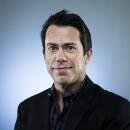KCET creates new identity after PBS
Life after PBS hasn’t been easy for KCET-TV Channel 28. But over the last few weeks, executives with the nation’s largest independent public broadcaster believe they may have turned a corner.
Starting Jan. 1, when it left the network after disputes over dues and other issues, the station lost signature PBS programs such as “Sesame Street,” “NewsHour” and “Charlie Rose.” Viewership and donations plummeted. But last week KCET announced an upcoming move to a Burbank office tower as The Times revealed that it sold its existing Los Feliz studio lot for a higher-than-expected $42 million, which officials say will help stabilize the station’s finances.
KCET is also embarking on an ambitious programming slate as it forges a new identity for viewers, and station officials say donations are slowly inching back after a difficult time earlier this year, when station insiders buzzed that the cost of putting on pledge drives exceeded their intake in donations.
“We’re past PBS,” KCET President and Chief Executive Al Jerome said in a recent interview at his office on the lot, which the station sold to the Church of Scientology earlier this year and must vacate by late April of next year. “We’re doing our own thing now. All we have to do is stay to our game plan, and we’re gonna do just fine.”
Among the new programs KCET is developing are “L.A. Tonight with Roy Firestone,” a talk show featuring the sportscaster interviewing noted Angelenos such as TMZ’s Harvey Levin and record producer David Foster; “Global Watch,” a weekly half-hour foreign affairs show hosted by the author Reza Aslan; and “Live at the Ford,” a performing-arts program showcasing acts at the Ford Amphitheatre in Los Angeles.
“The Time to Care” is a multi-platform show that will be targeted at elder caregivers, in much the same way that KCET’s “A Place of Our Own”/”Los Niños en Su Casa” brought tips and practical advice for caregivers of preschool children.
KCET has also drawn plaudits for airing news programs from Al Jazeera, the BBC and Japanese broadcaster NHK that brought viewers relevant global news during the “Arab Spring” protests and the Japanese earthquake and tsunami earlier this year.
Despite such strides, though, KCET’s withdrawal from PBS was a shock to the system for public broadcasting, and both network and station are still struggling to recover. Indeed, the overall health of PBS remains a concern. Funding to public broadcasting has come under attack from conservative legislators.
And KCET is not the only station to have left the system. The Orlando, Fla., member station exited after being sold to a religious broadcaster and was replaced by a college station. But PBS officials say they’re holding the line against further defections.
“Our system is undergoing a transition as we move from a structure that was largely based in the original analog broadcast model to one that meets the needs of a multi-platform digital world. Station collaborations, consolidations and mergers are all part of that transition,” said PBS chief Paula Kerger. “As shifts have occurred, stations have stepped forward with new partnerships and operation models to meet the needs of viewers.”
Locally, ratings show that viewers are still a bit puzzled by the change. When PBS programs went off KCET, KOCE-TV Channel 50 in Orange County took up most of the slack and rechristened itself PBS SoCal.
For May, KCET’s averaged 1.3 million total viewers per week, according to the Nielsen Co., a drop of 28% compared with the same period a year earlier. PBS SoCal was at 1.2 million, representing a 23% jump from a year ago.?
PBS SoCal is nowhere near the 1.9 million viewers KCET was averaging in May 2010. The numbers suggest that both stations have a lot of work to do in connecting with their audience base.?
KCET officials point out that their audience has grown since earlier this year. The May figures represented a 22% jump over February, they said.
Mel Rogers, president of PBS SoCal, said that while PBS fans were well aware of the station change, many “casual viewers” were not — and may have thus missed programs they otherwise would have watched. KOCE also has a higher channel position than KCET on many cable and satellite systems, further depressing viewership. And for reasons that mystify Rogers and the national PBS leadership, Latino kids haven’t tuned in to the PBS Kids’ block the way they did on KCET.
“For some reason, other kids made the switch but Hispanic children did not,” said Rogers, who will be breaking ground Thursday on a new studio headquarters for PBS SoCal in Costa Mesa. The station is preparing Spanish-language advertising to help combat the problem, he added — a step that cost-conscious PBS stations typically try to avoid. Another bright spot for PBS SoCal: Memberships are up since it took on the full PBS schedule.
Jerome, KCET’s boss, proudly points out that his station is beating PBS SoCal in certain time slots, such as evening news. But KCET still has to contend with critics and viewers who remain unimpressed with the station’s new direction.
“If this were a smaller market — I don’t want to pick on anyone — but perhaps Omaha or Fargo or someplace that were not at the center of the Hollywood beast,” said Lawrence Wenner, a media professor at Loyola Marymount University who has studied public broadcasting. “I’d say they’re doing a fair-to-middling job of being a resourceful public-broadcasting outlet in their community.”
While selling the lot may have made financial sense, Wenner added, he faulted the station for running too many “retreads” of British shows and movies “that would struggle to compete with someone’s $9 a month Netflix subscription.”
“I don’t have a clue, and I don’t think most viewers have a clue, what’s in store for the next chapter of KCET,” Wenner said.
KCET officials say that viewers will see soon enough.
Jerome said that foundations have continued coming through with vital support, and that the station’s operational costs will decrease substantially once it moves into the Burbank space — half the size of its Los Feliz offices and studios — next year.
“It’s not a one-year project,” Jerome said. “So far the trends have been up since January. We knew we were going to take a hit in January; we did. We took an audience hit, we took a fundraising hit. But now it’s starting to come back.”
More to Read
The complete guide to home viewing
Get Screen Gab for everything about the TV shows and streaming movies everyone’s talking about.
You may occasionally receive promotional content from the Los Angeles Times.







